Numerical Study of the Local Scouring Process and Influencing Factors of Semi-Exposed Submarine Cables
Abstract
:1. Introduction
2. Sediment Scouring Model
3. Numerical Setup and Modeling
3.1. Geometric Modeling and Mesh Division
3.2. Physical Field Setup
3.3. Mesh Independent Test
4. Results and Analysis
4.1. Analysis of Local Scouring Process
4.2. Influence Factors
4.2.1. Sediment’s Critical Shields Number
4.2.2. Sediment Density
4.2.3. Ocean Current Velocity
4.3. Variation Rule of Spanning Time
5. Conclusions
- Under the steady-state ocean currents, scouring holes will be formed at the upstream, wake position and downstream of the semi-exposed submarine cable. The upstream and downstream scouring holes develop faster, which will reach a temporary stable state at about 1 h after the start of the scouring. The scouring hole at the wake position will continue to expand at a slower rate and eventually lead to the spanning of the submarine cable.
- There is a close relationship between the distribution of shear velocity and the scouring terrain. As the local scouring process occurs, the location of the maximum shear velocity within the scouring hole shifts and causes the bottom of the hole to move as well.
- When the sediment’s critical Shields number and density are significantly large and ocean current velocity is sufficiently low, the duration of the stable state of the upstream scouring hole will be prolonged, and the average development velocity of the scouring holes at the wake position and downstream will be reduced.
- The relationship between the spanning time and the critical Shields number θcr can be formulated as a cubic function, in which the curve’s inflection point is θcr = 4.59 × 10−2. The relationship between spanning time and sediment density can be formulated as a linear function. The relationship between spanning time and ocean current velocity can be formulated by exponential function.
Author Contributions
Funding
Institutional Review Board Statement
Informed Consent Statement
Data Availability Statement
Acknowledgments
Conflicts of Interest
References
- Taormina, B.; Bald, J.; Want, A.; Thouzeau, G.; Lejart, M.; Desroy, N.; Carlier, A. A review of potential impacts of submarine power cables on the marine environment: Knowledge gaps, recommendations and future directions. Renew. Sust. Energ. Rev. 2018, 96, 380–391. [Google Scholar] [CrossRef]
- Gulski, E.; Anders, G.J.; Jogen, R.A.; Parciak, J.; Siemiński, J.; Piesowicz, E.; Paszkiewicz, S.; Irska, I. Discussion of electrical and thermal aspects of offshore wind farms’ power cables reliability. Renew. Sust. Energ. Rev. 2021, 151, 111580. [Google Scholar] [CrossRef]
- Wang, W.; Yan, X.; Li, S.; Zhang, L.; Ouyang, J.; Ni, X. Failure of submarine cables used in high-voltage power transmission: Characteristics, mechanisms, key issues and prospects. IET Gener. Transm. Distrib. 2021, 15, 1387–1402. [Google Scholar] [CrossRef]
- Chen, H.; Chen, Z.; Lu, H.; Wu, C.; Liang, J. Protection method for submarine cable detection and exposed suspension problem in Qiongzhou straits. Telecom Pow. Technol. 2019, 36, 60–61+63. [Google Scholar]
- Zhu, J.; Ren, B.; Dong, P.; Chen, W. Vortex-induced vibrations of a free spanning submarine power cable. Ocean Eng. 2023, 272, 113792. [Google Scholar] [CrossRef]
- Sumer, B.M.; Jensen, H.R.; Mao, Y.; Fredsøe, J. Effect of lee-wake on scour below pipelines in current. J. Waterw. Port Coast. Ocean. Eng. 1988, 114, 599–614. [Google Scholar] [CrossRef]
- Chiew, Y.M. Prediction of maximum scour depth at submarine pipelines. J. Hydraul. Eng. 1991, 117, 452–466. [Google Scholar] [CrossRef]
- Mastbergen, D.R.; Vandenberg, J.H. Breaching in fine sands and the generation of sustained turbidity currents in submarine canyons. Sedimentology 2003, 50, 625–637. [Google Scholar] [CrossRef]
- Dey, S.; Singh, N.P. Clear-water scour depth below underwater pipelines. J. Hydro-Env. Res. 2007, 1, 157–162. [Google Scholar] [CrossRef]
- Dey, S.; Singh, N.P. Clear-water scour below underwater pipelines under steady flow. J. Hydraul. Eng. 2008, 134, 588–600. [Google Scholar] [CrossRef]
- Liang, D.; Cheng, L. Numerical study of scour around a pipeline bundle. Proc. Inst. Civil Eng. Mar. Eng. 2008, 161, 89–95. [Google Scholar] [CrossRef]
- Yang, L.; Guo, Y.; Shi, B.; Kuang, C.; Xu, W.; Cao, S. Study of scour around submarine pipeline with a rubber plate or rigid spoiler in wave conditions. J. Waterw. Port Coast. Ocean Eng. 2012, 138, 484–490. [Google Scholar] [CrossRef]
- Li, Y.; Ong, M.C.; Fuhrman, D.R.; Larsen, B.E. Numerical investigation of wave-plus-current induced scour beneath two submarine pipelines in tandem. Coast. Eng. 2020, 156, 103619. [Google Scholar] [CrossRef]
- Guan, D.; Hsieh, S.C.; Chiew, Y.M.; Low, Y.M.; Wei, M. Local scour and flow characteristics around pipeline subjected to vortex-induced vibrations. J. Hydraul. Eng. 2020, 146, 04019048. [Google Scholar] [CrossRef]
- Liu, M.M.; Jin, X.; Wang, L.; Yang, F.; Tang, J. Numerical investigation of local scour around a vibrating pipeline under steady currents. Ocean Eng. 2021, 221, 108546. [Google Scholar] [CrossRef]
- Huang, J.; Yin, G.; Ong, M.C.; Myrhaug, D.; Jia, X. Numerical investigation of scour beneath pipelines subjected to an oscillatory flow condition. J. Mar. Sci. Eng. 2021, 9, 1102. [Google Scholar] [CrossRef]
- Cui, F.; Du, Y.; Hao, X.; Peng, S.; Bao, Z.; Peng, S. Experimental study on local scour and related mechanical effects at river-crossing underwater oil and gas pipelines. Adv. Civ. Eng. 2021, 2021, 6689212. [Google Scholar] [CrossRef]
- Li, B.; Ma, H. Scouring mechanism of suspended and partially-buried pipelines under steady flow. Coast. Eng. 2022, 177, 104201. [Google Scholar] [CrossRef]
- Najafzadeh, M.; Oliveto, G. Scour propagation rates around offshore pipelines exposed to currents by applying data-driven models. Water 2022, 14, 493. [Google Scholar] [CrossRef]
- Zhu, Y.; Xie, L.; Wong, T.; Su, T. Development of three-dimensional scour below pipelines in regular waves. J. Mar. Sci. Eng. 2022, 10, 124. [Google Scholar] [CrossRef]
- Ma, H.; Li, B. CFD-CGDEM coupling model for scour process simulation of submarine pipelines. Ocean Eng. 2023, 271, 113789. [Google Scholar] [CrossRef]
- Hu, K.; Bai, X.; Vaz, M.A. Numerical simulation on the local scour processing and influencing factors of submarine pipeline. J. Mar. Sci. Eng. 2023, 11, 234. [Google Scholar] [CrossRef]
- Yang, B.; Gao, F.; Wu, Y. Experimental study on local scour of sandy seabed under submarine pipeline in unidirectional currents. Eng. Mech. 2008, 25, 206–210. [Google Scholar]
- Cheng, Y.; Wang, X.; Luo, W.; Huang, X.; Lyu, X. Experimental study of local scour around a downstream inclined pile under combined waves and current. Adv. Eng. Sci. 2021, 53, 64–71. [Google Scholar]
- Lu, Y.; Zhou, L.; Shen, X. Different turbulence models for simulating a liquid-liquid hydro cyclone. J. Tsinghua Univ. 2001, 41, 105–109. [Google Scholar]
- Yun, D.H.; Kim, Y.T. Experimental study on settlement and scour characteristics of artificial reef with different reinforcement type and soil type. Geotext. Geomembr. 2018, 46, 448–454. [Google Scholar] [CrossRef]
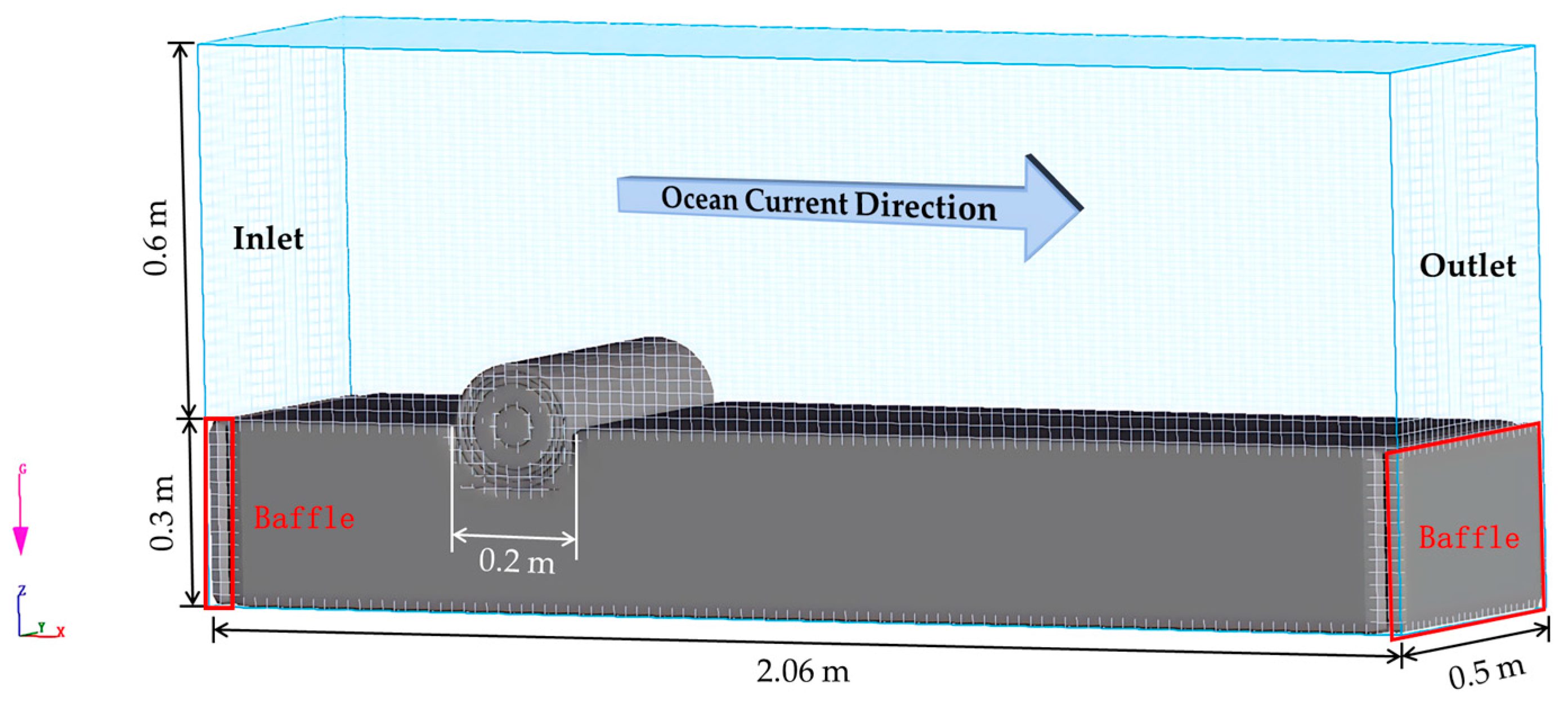

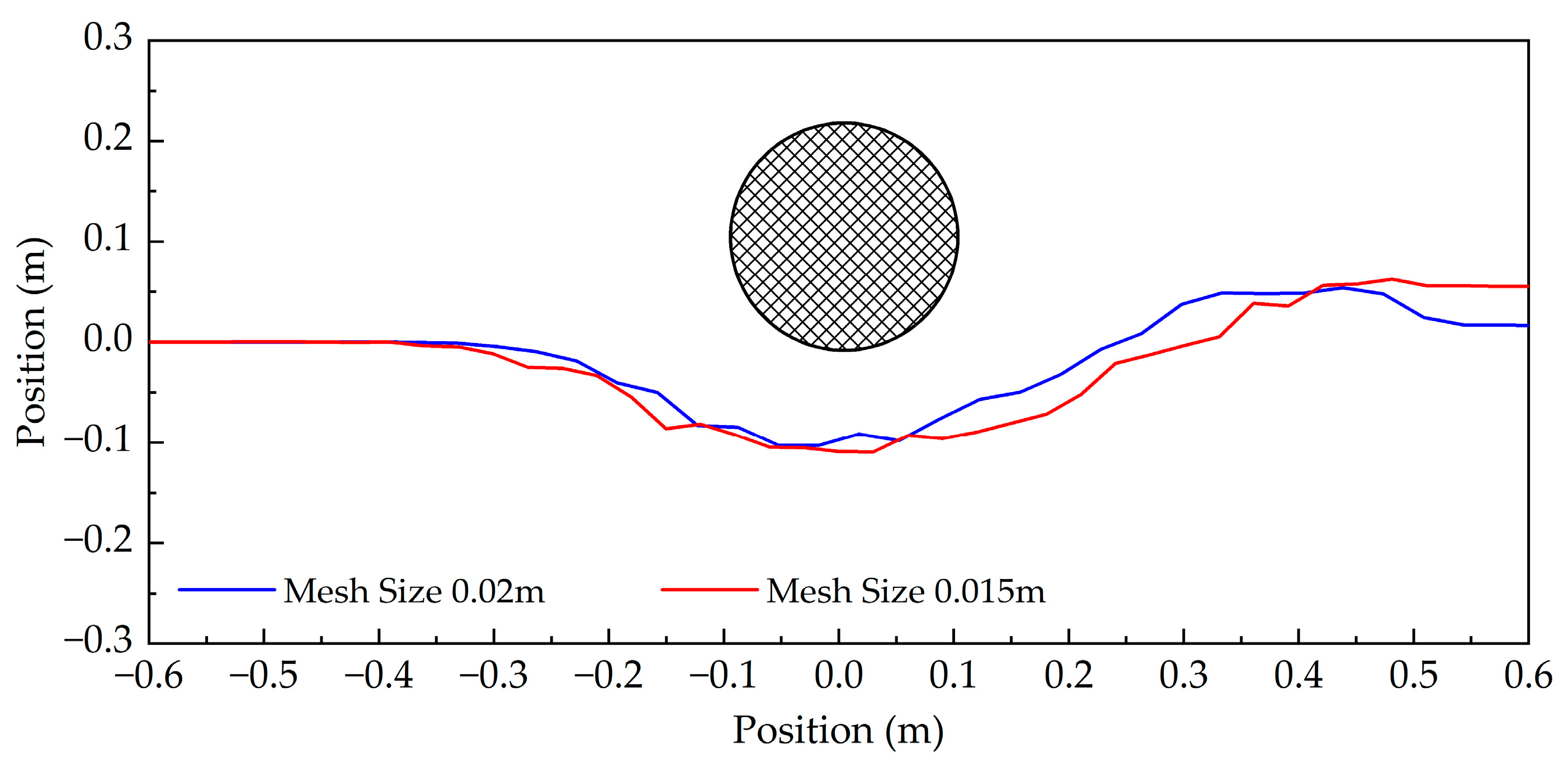
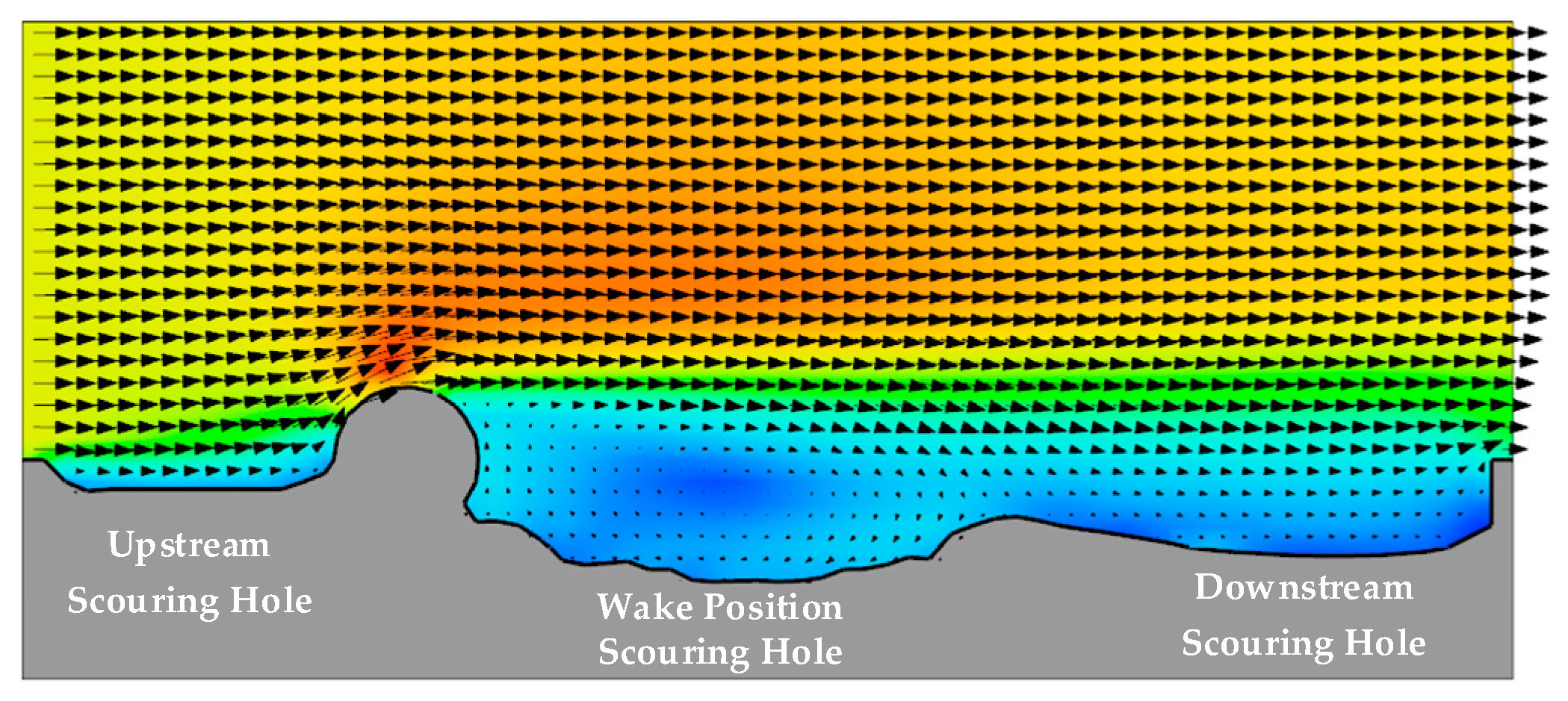

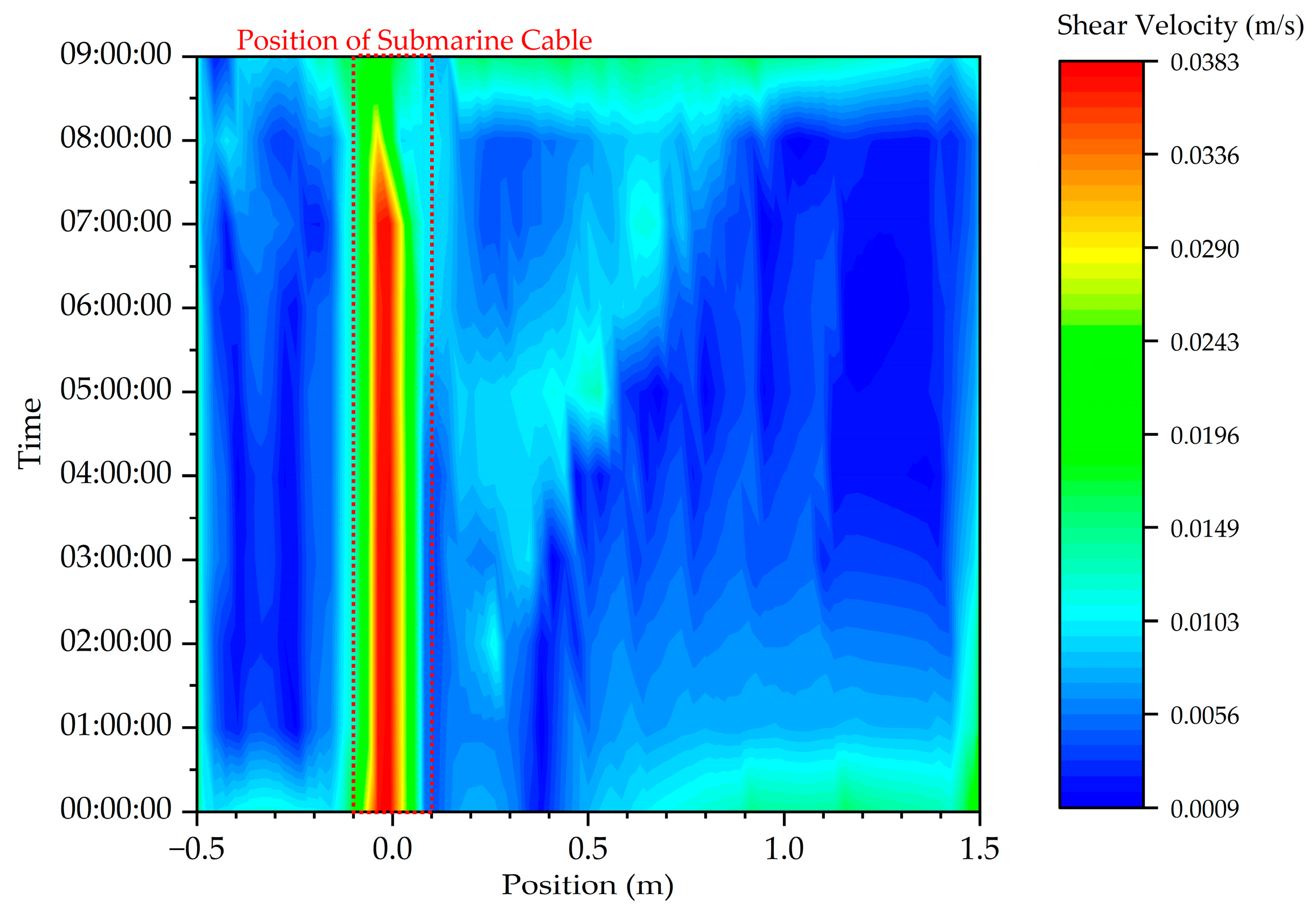

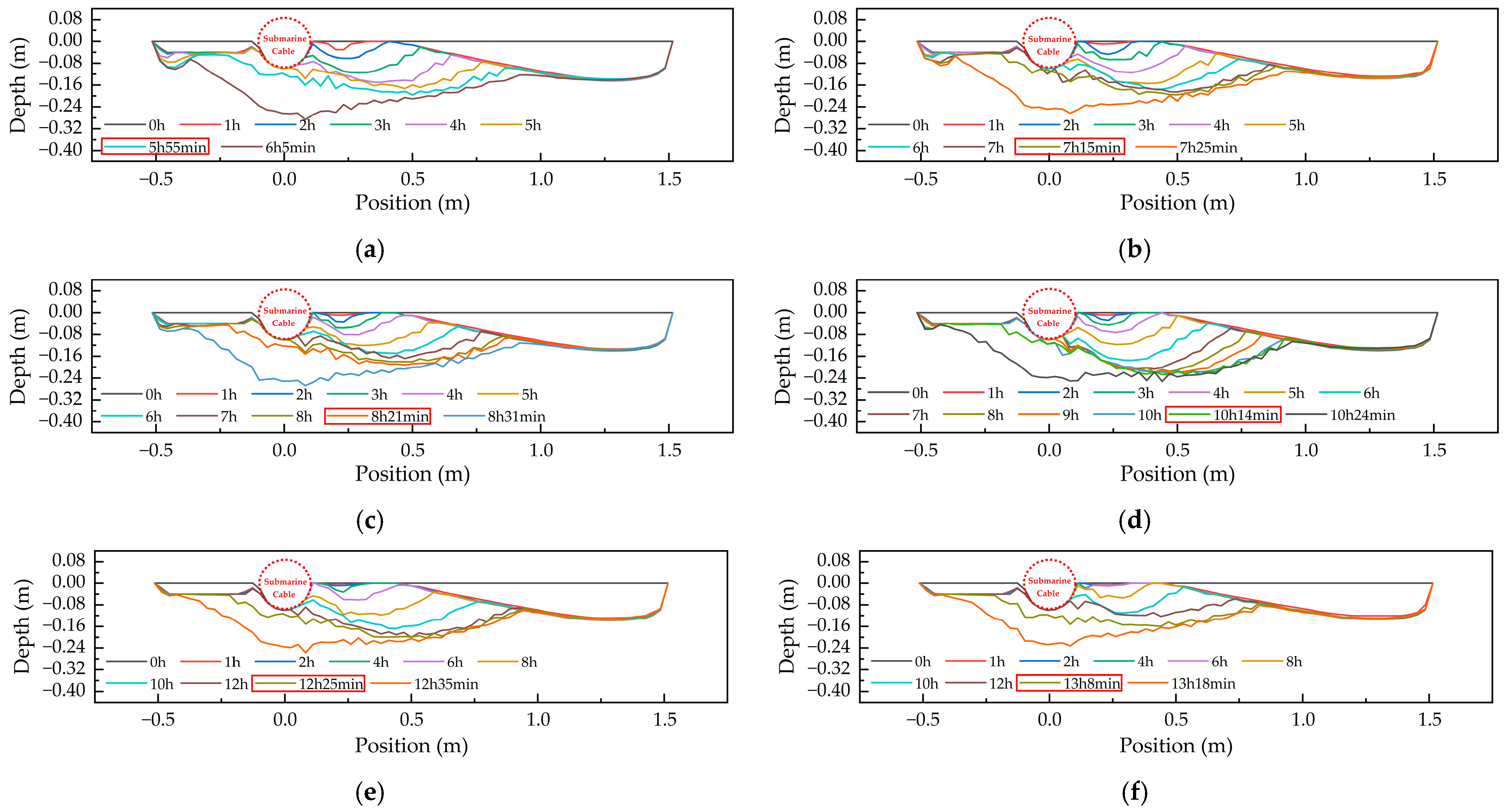


| Parameter | Value |
|---|---|
| Sediment Diameter | 8.5 × 10−5 m |
| Sediment Density | 1650 kg/m3 |
| Sediment Critical Shields Number | 0.05 |
| Fluid Density | 1000 kg/m3 |
| Fluid Viscosity | 0.01 kg/(m·s) |
| Gravitational Acceleration | −9.81 m/s2 |
Disclaimer/Publisher’s Note: The statements, opinions and data contained in all publications are solely those of the individual author(s) and contributor(s) and not of MDPI and/or the editor(s). MDPI and/or the editor(s) disclaim responsibility for any injury to people or property resulting from any ideas, methods, instructions or products referred to in the content. |
© 2023 by the authors. Licensee MDPI, Basel, Switzerland. This article is an open access article distributed under the terms and conditions of the Creative Commons Attribution (CC BY) license (https://creativecommons.org/licenses/by/4.0/).
Share and Cite
Li, Q.; Hao, Y.; Zhang, P.; Tan, H.; Tian, W.; Chen, L.; Yang, L. Numerical Study of the Local Scouring Process and Influencing Factors of Semi-Exposed Submarine Cables. J. Mar. Sci. Eng. 2023, 11, 1349. https://doi.org/10.3390/jmse11071349
Li Q, Hao Y, Zhang P, Tan H, Tian W, Chen L, Yang L. Numerical Study of the Local Scouring Process and Influencing Factors of Semi-Exposed Submarine Cables. Journal of Marine Science and Engineering. 2023; 11(7):1349. https://doi.org/10.3390/jmse11071349
Chicago/Turabian StyleLi, Qishun, Yanpeng Hao, Peng Zhang, Haotian Tan, Wanxing Tian, Linhao Chen, and Lin Yang. 2023. "Numerical Study of the Local Scouring Process and Influencing Factors of Semi-Exposed Submarine Cables" Journal of Marine Science and Engineering 11, no. 7: 1349. https://doi.org/10.3390/jmse11071349
APA StyleLi, Q., Hao, Y., Zhang, P., Tan, H., Tian, W., Chen, L., & Yang, L. (2023). Numerical Study of the Local Scouring Process and Influencing Factors of Semi-Exposed Submarine Cables. Journal of Marine Science and Engineering, 11(7), 1349. https://doi.org/10.3390/jmse11071349







